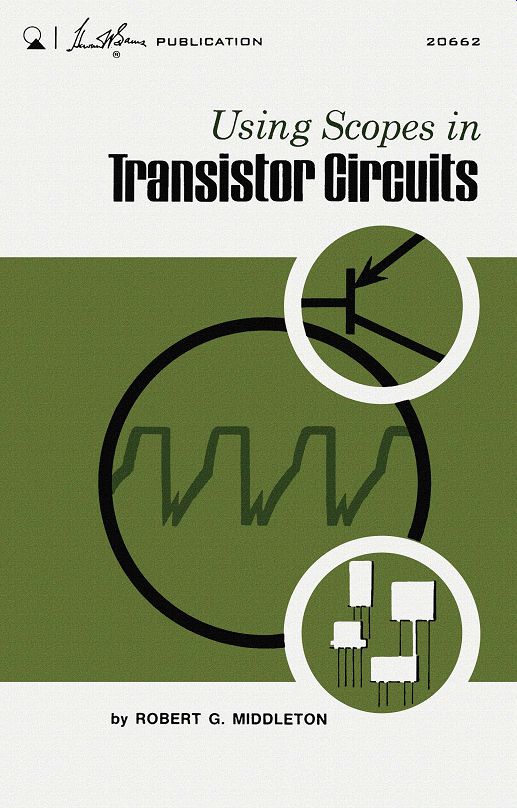AMAZON multi-meters discounts AMAZON oscilloscope discounts

Contents
SECTION 1--SEMICONDUCTOR PRINCIPLES AND WAVEFORM ANALYSIS: Basic Waveform Analysis-Waveforms in Transistor Amplifier Circuits-Pulse Voltages-Rise-Time Measurement-Action of Triggered-Sweep Controls
SECTION 2--WAVEFORMS IN TRANSISTOR OSCILLATORS: Blocking Oscillators-Transistor Multivibrators
SECTION 3--OTHER TRANSISTOR OSCILLATORS AND WAVEFORMS: RC Circuit Differentiation Versus Mathematical Differentiation-Expansion of Rectangular Waveforms-Sinusoidal Transistor Oscillators
SECTION 4--TRANSISTOR AMPLIFIERS AND WAVEFORMS: Frequency Response of RC-coupled Amplifiers-Square-Wave Response of RC-Coupled Amplifiers-Low-Frequency Boost Circuit-Approximate Measurement of Rise Time
SECTION 5--TRANSFORMER-COUPLED, IMPEDANCE-COUPLED, AND DIRECT-COUPLED AMPLIFIERS: Transient Response of Untuned Transformer-Tuned Trans former-Impedance-Coupled Amplifiers-Direct-Coupled Amplifiers
SECTION 6--WAVEFORMS IN TRANSISTOR WA VESHAPING CIRCUITS: Saturation Limiting-Cutoff and Saturation Limiting-Transistor Clipper Circuits-Transistor Switch Waveshapers
SECTION 7--TRANSISTOR BLACK-AND-WHITE TV CIRCUITS AND WAVEFORMS: Signal-Tracing Procedures-Waveform Analysis-Frequency Response Curves-Square-Wave Tests
SECTION 8--TRANSISTOR COLOR-TV CIRCUITS AND WAVEFORMS: General Survey of the Color Circuitry-Chroma Waveform Fundamentals-Chroma Signal Processing-Chroma Sync Waveforms-Frequency-Response Curves-Other Color-Receiver Waveforms
SECTION 9 -- TRANSISTOR ELECTRONIC COMPUTERS AND WAVEFORMS: Rise-Time Considerations-Storage Time-Fall Time-Reduction of IcEo-Cutoff and Saturation Clamping-Pulse Regeneration-Machine-Logic Circuits
INDEX
This guide is based on the 1968 H.W. Sams book Using Scopes in Transistor Circuits.
Preface
Scope application in transistor circuits is similar in various respects to application in vacuum-tube circuits. However, there are many unexpected situations encountered in transistor circuits because a transistor is a solid-state current-operated device, whereas a tube is an evacuated, voltage-operated device.
A tube conducts current only by means of electrons, whereas a transistor conducts current by means of two charge carriers called electrons and holes. The electrons in a tube flow from cathode to plate because of electric field forces. In a transistor, electrons and holes flow partially because of electric fields (drift fields), and partially because of the diffusion effect. The diffusion effect can be compared with the expansion of hydrogen gas injected at the neck of a balloon. Because of mutual repulsion of the hydrogen molecules, the injected gas diffuses throughout the balloon.
In the base of a transistor, electrons or holes cannot be removed by a drift field. Charge carriers stored in the base region can be removed only by diffusion. Therefore, because of storage time, we encounter waveform distortions that are not found in vacuum-tube circuits. Furthermore, because a transistor is a current-operated device, we will discover that the input-current waveform to a transistor is distorted by an unexpected polarity reversal at the termination of the input drive pulse. In turn, waveform analysis in fast-acting transistor circuits is quite different from that in corresponding tube circuits. We will find that even semiconductor diodes produce unexpected output waveforms in high-speed switching circuits.
If we intend to use scopes intelligently in transistor circuits, we need to have a good understanding of transistor circuit action. Therefore, transistor circuit action is explained in this guide wherever it has a direct bearing on waveform analysis.
A wide range of technology has been covered, with emphasis on those configurations that are of key importance in the operation of most transistor equipment. Although the guide has been written chiefly from the standpoint of the electronic technician, the depth of treatment is adequate to meet the needs of students in junior colleges and technical institutes. Mathematics has been held to a practical minimum, but some equations have been included at points where they contribute substantially to understanding of circuit action.
Many diagrams and waveforms are presented to show clearly the developments and conclusions of the text discussion. Quizzes have been added at the end of each Section so that the reader may check his progress. It is assumed that the reader is familiar with operation of service-type scopes, and that he has a basic knowledge of the principles involved in triggered sweep scope operation. If the reader lacks this knowledge, he is advised to refer to basic scope-operation books. Whenever possible, it is advisable to check out the scope tests in practice.
Facility in scope operation and waveform analysis can be obtained only by a combination of study and practical experience.
ROBERT G. MIDDLETON
Also see:
Guide to Transistor Circuits (late 1950s)
Troubleshooting With the Oscilloscope
Scope Waveform Analysis (1963)